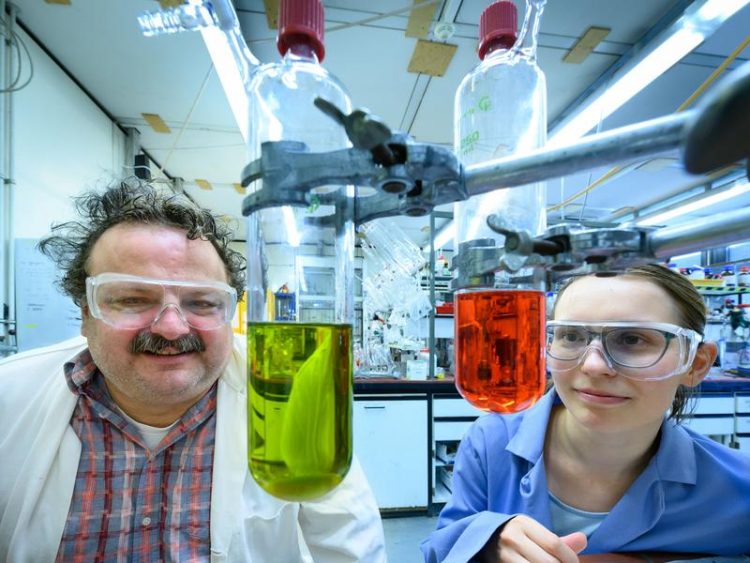Chemical juggling with three particles

Prof. Dr. Andreas Gansäuer and Anastasia Panfilova during epoxy hydrogenation at the Kekulé Institute of Organic Chemistry and Biochemistry at the University of Bonn. © Photo: Volker Lannert/Uni Bonn
Alcohols are common chemical compounds which, in addition to carbon and hydrogen, contain at least one OH group. They serve as starting materials for a whole series of chemical syntheses and are often produced directly from olefins by addition of water (chemical formula: H2O).
Olefins are hydrocarbons with a double bond available from oil. The water molecule serves as a “donor” of the OH-group characteristic of alcohols.
This synthesis is simple and efficient, but it has a decisive disadvantage: It can only be used to produce certain alcohols, the so-called “Markovnikov alcohols”.
The OH group cannot simply be attached to any position of the olefin – one of two positions is excluded. “We have now found a new catalytic method that can produce exactly these ‘impossible’ alcohols,” explains Prof. Dr. Andreas Gansäuer.
Gansäuer works at the Kekulé Institute of Organic Chemistry and Biochemistry at the University of Bonn. The idea for the new synthesis emerged in 2013 in a collaboration with the group of Prof. Dr. Jack Norton of Columbia University in New York.
However, it took almost five years until the synthesis of the so-called “anti-Markovnikov alcohol” using the new catalytic system worked well enough to be published.
Acceleration and slowing down by the catalysts’ ligands
The fact that the two groups succeeded in making it into the renowned journal ‘Science’ is due to the unusual reaction mechanism. Epoxides, common and valuable intermediate products of the chemical industry, serve as starting materials. Epoxides can be produced by adding an oxygen atom (chemical symbol: O) to olefins. If they are allowed to react with hydrogen molecules (H2), the oxygen becomes an OH group. Normally, with this approach only Markovnikov alcohols are produced.
“In our reaction, however, we successively transfer the hydrogen in three parts,” explains Gansäuer. “First a negatively charged electron, then a neutral hydrogen atom and finally a positively charged hydrogen ion, a proton. We use two catalysts, one of which contains titanium and the other chromium. “This allows us to convert epoxides into anti-Markovnikov alcohols.”
The timing of the entire process must be strictly coordinated – like in juggling, where each ball has to maintain a specified flight duration. To achieve this, the chemists had to synchronize the speed of three catalytic reactions. To this end, they attached the ‘right’ ligands, molecules that control the metals’ reactivity, to the titanium and chromium atoms.
Until now, anti-Markovnikov alcohols have been produced through a so-called hydroboration followed by an oxidation. However, this reaction is relatively complex and not particularly sustainable. The new mechanism, on the other hand, does not produce any by-products and is thus practically waste-free. “Titanium and chromium are also very common metals, unlike many other noble metals that are often used in catalysis,” Gansäuer emphasizes.
In 2013, Norton and Gansäuer submitted their idea to a call for proposals on sustainable catalysis by the International Union of Pure and Applied Chemistry (IUPAC), winning first place. The project was largely financed with the grant money. “But the good cooperation within my institute has certainly also contributed to the success,” emphasizes Gansäuer. “For instance, I had access not only to the institute's resources, but also to equipment of the other groups from Bonn.”
Prof. Dr. Andreas Gansäuer
Kekulé Institute of Organic Chemistry and Biochemistry
University of Bonn
Tel. +49(0)228/732800
E-mail: andreas.gansaeuer@uni-bonn.de
Chengbo Yao, Tobias Dahmen, Andreas Gansäuer, Jack Norton: Anti-Markovnikov alcohols via epoxide hydrogenation through cooperative catalysis. Science, DOI: 10.1126/science.aaw3913
Media Contact
More Information:
http://www.uni-bonn.de/All latest news from the category: Life Sciences and Chemistry
Articles and reports from the Life Sciences and chemistry area deal with applied and basic research into modern biology, chemistry and human medicine.
Valuable information can be found on a range of life sciences fields including bacteriology, biochemistry, bionics, bioinformatics, biophysics, biotechnology, genetics, geobotany, human biology, marine biology, microbiology, molecular biology, cellular biology, zoology, bioinorganic chemistry, microchemistry and environmental chemistry.
Newest articles

NASA: Mystery of life’s handedness deepens
The mystery of why life uses molecules with specific orientations has deepened with a NASA-funded discovery that RNA — a key molecule thought to have potentially held the instructions for…

What are the effects of historic lithium mining on water quality?
Study reveals low levels of common contaminants but high levels of other elements in waters associated with an abandoned lithium mine. Lithium ore and mining waste from a historic lithium…

Quantum-inspired design boosts efficiency of heat-to-electricity conversion
Rice engineers take unconventional route to improving thermophotovoltaic systems. Researchers at Rice University have found a new way to improve a key element of thermophotovoltaic (TPV) systems, which convert heat…



